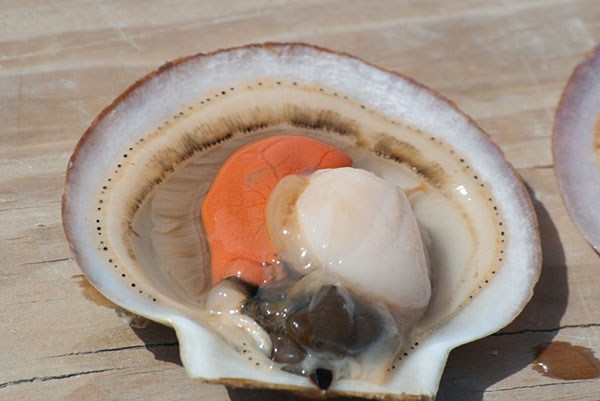Scallops
Species Description
Atlantic sea scallop Placopecten magellanicus
Wild. Research efforts to culture scallops are ongoing, but limited cultured products are currently available.
The Atlantic sea scallop ranges from Labrador to the Outer Banks of North Carolina. What we call a “scallop” is one part of the sea scallop animal, the adductor muscle. This muscle is more developed in the scallop than in oysters and clams because scallops are active swimmers, and use the muscle to open and close their shell, a motion which propels them through the water.
Season
View 2024-2025 scallop season information from the Maine Department of Marine Resources (DMR).
Status
In recent years, declining numbers of scallops in state waters prompted DMR to implement emergency and experimental closures to protect the resource. The season is restricted according to “zones,” with areas closed as they approach unsustainable harvesting levels.
Atlantic sea scallops in federal waters along the Northwestern Atlantic Coast are not overfished nor is overfishing occurring. Offshore scallop fishing areas (beyond three miles from shore) are opened and closed on a rotational basis, with a limit on total annual catch and limits on bycatch of yellowtail flounder. The fishery is also scheduled to protect sea turtles (Fishwatch.gov).
Regulatory Authority
Inshore fishery is managed by the DMR. Offshore fishery governed by the New England Fishery Management Council.
Harvest Method
The majority of scallops are harvested by mechanical drag; in state waters some are harvested by hand by SCUBA divers (“dive caught” or “diver scallops”). Scallops are shucked on the boat shortly after being harvested. See the vessel and gear guide for more information.
Quantities of cultured product available are slowly increasing due in part to ongoing research efforts and emerging scallop farms.
While there are ongoing research efforts to develop reliable techniques to raise scallop seed in a hatchery setting, farmers still rely on wild-caught spat.
Recreational Harvest
Recreational SCUBA divers may take scallops with a non-commercial marine harvesting license from the Department of Marine Resources. It is unlawful to take scallops during nighttime hours (sunset to sunrise). A person may not use a drag, but must obtain a diver certification.
Minimum size is four inches along the longest diameter, maximum harvest is 1 gallon of shucked meats or 1.5 bushels of live scallops. Details can be found in Chapter 623 of Maine Revised Statutes
Shellfish recreational limits: The one peck per day limit is for a combined total regardless of species harvested. Towns may also require recreational licenses although the state does not require a license to harvest for personal consumption.
Health Benefits & Risks
Scallops are a low-fat and low-calorie source of selenium, but contain lower amounts of omega-3 fatty acids compared to other seafood choices. Scallops are low in mercury. Some aquaculture producers in Maine are allowed to sell whole/live product; be sure to purchase from reputable and licensed dealers.
View the 2021 US Food and Drug Administration’s fish consumption guidelines.
Buying & Preparing
Fresh scallops keep refrigerated for a few days and freeze well for longer storage. When buying, look for “dry” scallops ( not soaked in sodium tripolyphosphate, which can sometimes appear as a milky white liquid in the container). Scallop meat may range from ivory to cream, with occasional hints of orange or gray, and should have a fresh, sweet aroma.
Labels like “dayboat,” “dive,” or “diver” indicate scallops harvested in Maine’s state waters and are typically available fresh only during the winter scallop season. Live or whole scallops should be used within five days of harvest for best quality.
Recipes
Certifications & Verifications
Gulf of Maine Responsibly Harvested
Links
- NOAA Fisheries Species Directory

